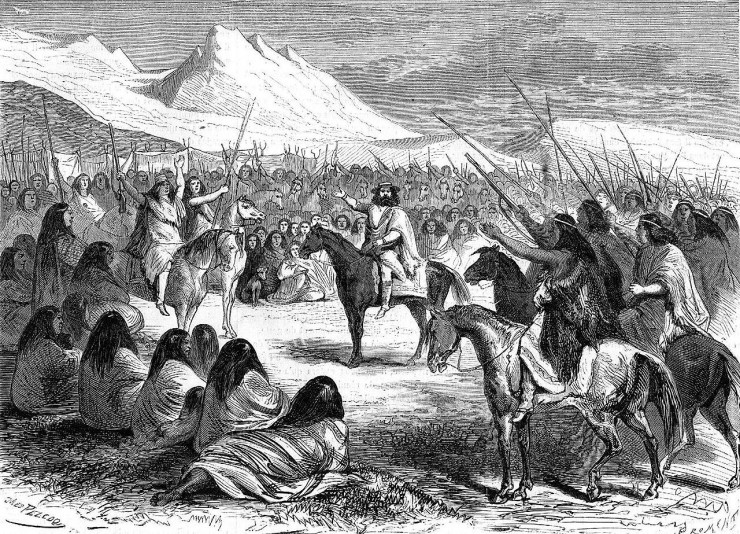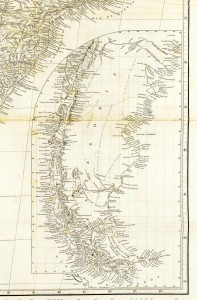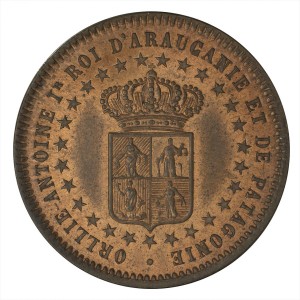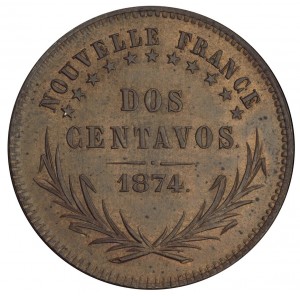Coins from a nation that wasn’t: Araucania and Patagonia
By David Bergeron, Curator
D’Antoine de Tounens in a meeting with the Mapuche people of Patagonia. (Wikimedia Commons, Jules Peco?)
It is not unusual for “micro-nations”— city-states, principalities or minor kingdoms—to produce their own currency. Having a national currency is one way that a fledgling nation can promote its independence—sometimes before there even is a nation. But this coin, from a purely conceptual country in South America, is most intriguing for the history it now represents: the attempt of an indigenous people to establish their own nation in the face of colonization. Even more intriguing, what’s stamped on the coin implies this imaginary nation had already been colonized–by France.
Patagonia from the survey by the British ships Adventure and Beagle. (Wikimedia Commons, John Arrowsmith, 1842)
In the middle of the 19th century, a French lawyer and adventurer named d’Antoine de Tounens became fascinated by the Mapuche people of the Patagonia region of South America. The Mapuche were struggling to protect their ancestral lands, their identity and their culture from colonial expansion by the governments of Chile and Argentina. De Tounens went to Chile in 1858 to meet the Mapuche, whom he admired for what he regarded as their heroic resistance, and took up their campaign for self‑determination and sovereignty. In co-operation with their leaders, de Tounens drafted a constitution for “Araucania and Patagonia”, a region located in the southern half of modern Chile and Argentina. They declared the district a kingdom and de Tounens was named as its first monarch. The Chilean government arrested him in 1862, put him on trial and declared him insane. Narrowly avoiding execution, de Tounens was deported to France.
The National Currency Collection possesses three 2-centavo coins minted for Araucania and Patagonia in 1874. What is so curious about these coins is that they claim this potential nation for France. The legend on the reverse reads “NOUVELLE FRANCE / DOS / CENTAVOS / 1874". De Tounens appeared to have baptized the nation as part of New France, yet this designation is seen nowhere else but on the coins. The coins don’t originate from South America but by some accounts may have been struck, presumably at de Tounens’ request, in Belgium.
De Tounens intended to take the coins back with him to Patagonia to help re-establish his kingdom. Although he returned and failed on several occasions, a number of countries did choose to recognize his fledgling state. But it was not to be. In 1878, Orélie-Antoine de Tounens (as his magisterial name was) died in France as the exiled King of Araucania and Patagonia. A successor to the office of Royal Highness to the Crown of Araucania and Patagonia (in exile) still lives in France today–Prince Antoine IV.
The Museum Blog
A mythic metal: Some stories of gold coins
By: Krista Broeckx
In 1896, three enterprising men struck gold in the Klondike region of the Yukon. Their story is just one of many that illustrates the allure of gold through the ages.
Virtual Worlds. Real Economies.
By: Adam Young
The economies in modern, complex video games can teach gamers a lot about decision making and financial literacy.
Fur Trade Economics
Over its 350-year lifespan, the Hudson’s Bay Company has had an enormous impact on Canada’s economy and how the nation was settled.
The house the Bank of Canada built
By: Graham Iddon
The Bank of Canada head office is two structures: the stone cube on Wellington Street and the glass structure that it is nestled into. Both are significant architectural landmarks.
Value is in the Eye of the Consumer
By: Graham Iddon
Supply and demand is part of the very bedrock of an economy. It's what generates the price of any product or service.
Mishap on the dollar
By: Graham Iddon
An image of a river of logs floating behind Parliament Hill has long lived in Canadian collective memory thanks to a bank note, the Scenes of Canada $1 bill.
The Last Smokestack
By: Graham Iddon
Putting an industrial facility on a bank note is not a casual decision. At the end of the 1960s, such places were earning a bad reputation for pollution. There was actually a good reason for this choice, but it wasn’t obvious to many Canadians.









